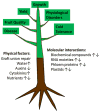Rootstock scion somatogenetic interactions in perennial composite plants
- PMID: 23793453
- PMCID: PMC4244527
- DOI: 10.1007/s00299-013-1471-9
Rootstock scion somatogenetic interactions in perennial composite plants
Abstract
The ancient plant production practice of grafting which instantly imparts new physiological properties to the desirable scion still remains shrouded in mystery. Yet, grafting remains a widely used technique in the production of several horticultural species. In a composite grafted plant, rootstocks control many aspects of scion growth and physiology including yield and quality attributes as well as biotic and abiotic stress tolerance. Broadly, physical, physiological, biochemical and molecular mechanisms have been reviewed to develop an integrated understanding of this enigmatic process that challenges existing genetic paradigms. This review summarizes the reported mechanisms underlying some of the economically important traits and identifies several key points to consider when conducting rootstock scion interaction experiments. Study of the somatogenetic interactions between rootstock and scion is a field that is ripe for discovery and vast improvements in the coming decade. Further, utilization of rootstocks based on a better understanding of the somatogenetic interactions is highly relevant in the current agricultural environment where there is a need for sustainable production practices. Rootstocks may offer a non-transgenic approach to rapidly respond to the changing environment and expand agricultural production of annual and perennial crops where grafting is feasible in order to meet the global food, fiber and fuel demands of the future.
Figures

Similar articles
-
Rootstocks: Diversity, Domestication, and Impacts on Shoot Phenotypes.Trends Plant Sci. 2016 May;21(5):418-437. doi: 10.1016/j.tplants.2015.11.008. Epub 2015 Dec 11. Trends Plant Sci. 2016. PMID: 26698413 Review.
-
Vegetable Grafting From a Molecular Point of View: The Involvement of Epigenetics in Rootstock-Scion Interactions.Front Plant Sci. 2021 Jan 7;11:621999. doi: 10.3389/fpls.2020.621999. eCollection 2020. Front Plant Sci. 2021. PMID: 33488662 Free PMC article. Review.
-
Getting to the root of grafting-induced traits.Curr Opin Plant Biol. 2021 Feb;59:101988. doi: 10.1016/j.pbi.2020.101988. Epub 2020 Dec 31. Curr Opin Plant Biol. 2021. PMID: 33388626 Review.
-
Epigenetic Changes and Transcriptional Reprogramming Upon Woody Plant Grafting for Crop Sustainability in a Changing Environment.Front Plant Sci. 2021 Jan 12;11:613004. doi: 10.3389/fpls.2020.613004. eCollection 2020. Front Plant Sci. 2021. PMID: 33510757 Free PMC article. Review.
-
Rootstock effects on leaf function and isotope composition in apple occurred on both scion grafted and ungrafted rootstocks under hydroponic conditions.Front Plant Sci. 2023 Dec 13;14:1274195. doi: 10.3389/fpls.2023.1274195. eCollection 2023. Front Plant Sci. 2023. PMID: 38155849 Free PMC article.
Cited by
-
Physiological, biochemical, and molecular aspects of grafting in fruit trees.Hortic Res. 2022 Feb 19;9:uhac032. doi: 10.1093/hr/uhac032. Online ahead of print. Hortic Res. 2022. PMID: 35184166 Free PMC article.
-
Rootstocks Overexpressing StNPR1 and StDREB1 Improve Osmotic Stress Tolerance of Wild-Type Scion in Transgrafted Tobacco Plants.Int J Mol Sci. 2021 Aug 5;22(16):8398. doi: 10.3390/ijms22168398. Int J Mol Sci. 2021. PMID: 34445105 Free PMC article.
-
Plant grafting: new mechanisms, evolutionary implications.Front Plant Sci. 2014 Dec 17;5:727. doi: 10.3389/fpls.2014.00727. eCollection 2014. Front Plant Sci. 2014. PMID: 25566298 Free PMC article. Review.
-
Dissection of the Mechanism for Compatible and Incompatible Graft Combinations of Citrus grandis (L.) Osbeck ('Hongmian Miyou').Int J Mol Sci. 2018 Feb 8;19(2):505. doi: 10.3390/ijms19020505. Int J Mol Sci. 2018. PMID: 29419732 Free PMC article.
-
Synthetic Polyploidy in Grafted Crops.Front Plant Sci. 2020 Nov 5;11:540894. doi: 10.3389/fpls.2020.540894. eCollection 2020. Front Plant Sci. 2020. PMID: 33224156 Free PMC article. Review.
References
-
- Agbaria H, Heuer B, Zieslin N. Rootstock-imposed alterations in nitrate reductase and glutamine synthetase activities in leaves of rose plants. Biol Plantarum. 1998;41(1):85–91.
-
- Almansa MS, Hernandez JA, Jimenez A, Botella MA, Sevilla F. Effect of salt stress on the superoxide dismutase activity in leaves of Citrus limonum in different rootstock–scion combinations. Biol Plantarum. 2002;45(4):545–549.
-
- Aloni B, Cohen R, Karni L, Aktas H, Edelstein M. Hormonal signaling in rootstock–scion interactions. Sci Hortic-Amsterdam. 2010;127(2):119–126. doi: 10.1016/j.scienta.2010.09.003. - DOI
-
- Basile B, Marsal J, DeJong TM. Daily shoot extension growth of peach trees growing on rootstocks that reduce scion growth is related to daily dynamics of stem water potential. Tree Physiol. 2003;23(10):695–704. - PubMed
Publication types
MeSH terms
Grants and funding
LinkOut - more resources
Full Text Sources
Other Literature Sources

